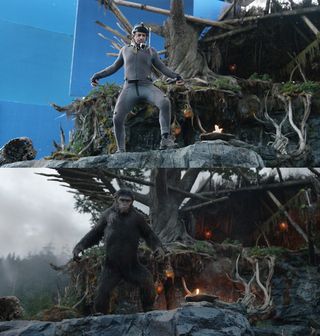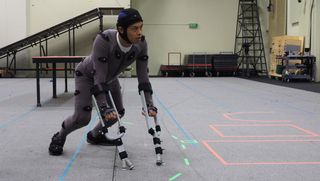Watch a man turn into an ape in 8 easy steps
An exclusive glimpse behind the scenes of the tech used to make Dawn Of The Planet Of The Apes

Dawn Of The Planet Of The Apes
New Zealand special effects house Weta has been at the forefront of motion capture since it threw Andy Serkis in a white jumpsuit and turned him into Gollum. And they once again worked on the performance capture for this year's Gary Oldman-starring Dawn Of The Planet Of The Apes.
Directed by Matt Reeves and written by Mark Bomback, Rick Jaffa and Amanda Silver, the movie (the eighth cinema release in the Apes franchise) also stars Andy Serkis, Jason Clarke, Keri Russell, Toby Kebbell, and Kodi Smit-McPhee. For its Blu-ray release (already out in the UK and Australia, out Tuesday 2 December in the US) 12DOVE got to travel to their Wellington studio to see firsthand how they turned actors into apes.

1. The Jumpsuits
Some things change, while others stay the same. While motion capture has come a long way since The Lord Of The Rings, the tight lycra body suit is a staple of motion capture.
Thats because the reference points those shiny balls that reflect the infrared light thats used to record mocap data cant move around on the actors body or else they throw the mocap data all out of whack.

2. Active Mocap
For Dawn Of The Planet Of The Apes, the team at Weta created a robust, active mocap jumpsuit. Instead of using reflective balls located around the body, it instead uses a series of infrared LEDs powered by a compact battery pack worn on the back of the suit.
This system allowed the Weta team to record motion capture data on location in the Vancouver rainforest rather than their warehouse mocap studio in Wellington, giving the cast and crew a much more natural recording environment.

3. The Reference Scan
Once the actors are all suited up, they stand on a small stage and get scanned for a series of bodily movements. These scans are recorded in real time to test the actors range of movement in a variety of poses and actions.
Some software then compresses the actors dimensions to that of the digital character they are playing, be it a slightly shorter, more muscular chimp in Dawn Of The Planet Of The Apes, or a taller, lankier Navi in Avatar.

4. The Mo-Cap Warehouse
Wetas mocap studio consists of several rooms, with an array of special cameras carefully set up around each room. Each camera lens is surrounded by powerful infrared LED lights, which beam out invisible light that reflects off the balls on the actors lycra suit. The cameras then record that information in three dimensions in real time.
The software is intelligent enough that it can superimpose characters on set into the shot with a low-resolution model of the actors character in real time, giving the team the opportunity to record the action in multiple takes, all without leaving the studio.

5. Crutch Walking
Because ape biology is somewhat different to human biology, what with the longer arms and powerful shoulders, for certain scenes the actors needed to walk around on set using special crutch-like arm extensions.
According to some of the actors used in the film, it took about an hours worth of intense training to get the hang of ape-movement, and was a pretty incredible thigh workout.

6. Facial Recording
What makes the Weta motion capture technology so impressive isnt just the characters movement, but the emotive performances the actors give. To capture that performance, the lead actors would often wear a head-mounted face camera, that captured every minute detail of the actors facial performance in real time.
This performance gave the animators a detailed reference that they could use to make the apes in the movie convey the wide gamut of emotions needed.

7. Facial Modelling
Theres a lot more to creating the final apes performance than just recording the actors face though. The team at Weta create highly detailed computer models of each character, based on real human and ape biology, with the ability to control every part of the apes face.
The model for Andy Serkis Ceasar, for example had over 240 muscle sets to control, giving the animators the tools to recreate every aspect of Serkis performance.

8. Animation
Once the facial model has been completed, its up to the animators to fine-tune the end result. Often, its a case of adding imperfections to create a level of believability, from leaves and dirt in the apes hair, to developing a system to display the effects of rain on the apes face and body.
In many cases, viewers wont actually notice many of the things the animators add to the frame, which is exactly what the effects team wants once you stop seeing a CGI creation and instead watch the digital character, their work is done. Thanks to Fox Australia for organising the trip to Weta to see the magic happen!
















